(Clicking on hyperlinks in the text will take you to original source documents, many of which are from the Eisenhower Library or other National Archives facilities and have never before been available online.)
Initial study
Eisenhower was well aware of the long-term importance of the national road network. Famously, as a young Army lieutenant colonel, he spent 62 miserable days in 1919 accompanying a road convoy from Washington D.C. to San Francisco across the largely dirt roads of the time.[1]
While still in New York City, during the pre-inaugural transition period, Eisenhower met with a Wall Street acquaintance, Walter Buckner, to discuss the prospect of building a national system of toll highways. On Eisenhower’s 16th day in office, Buckner came to Washington to deliver his report (with a proposed map of a 10,000-mile network).[2]
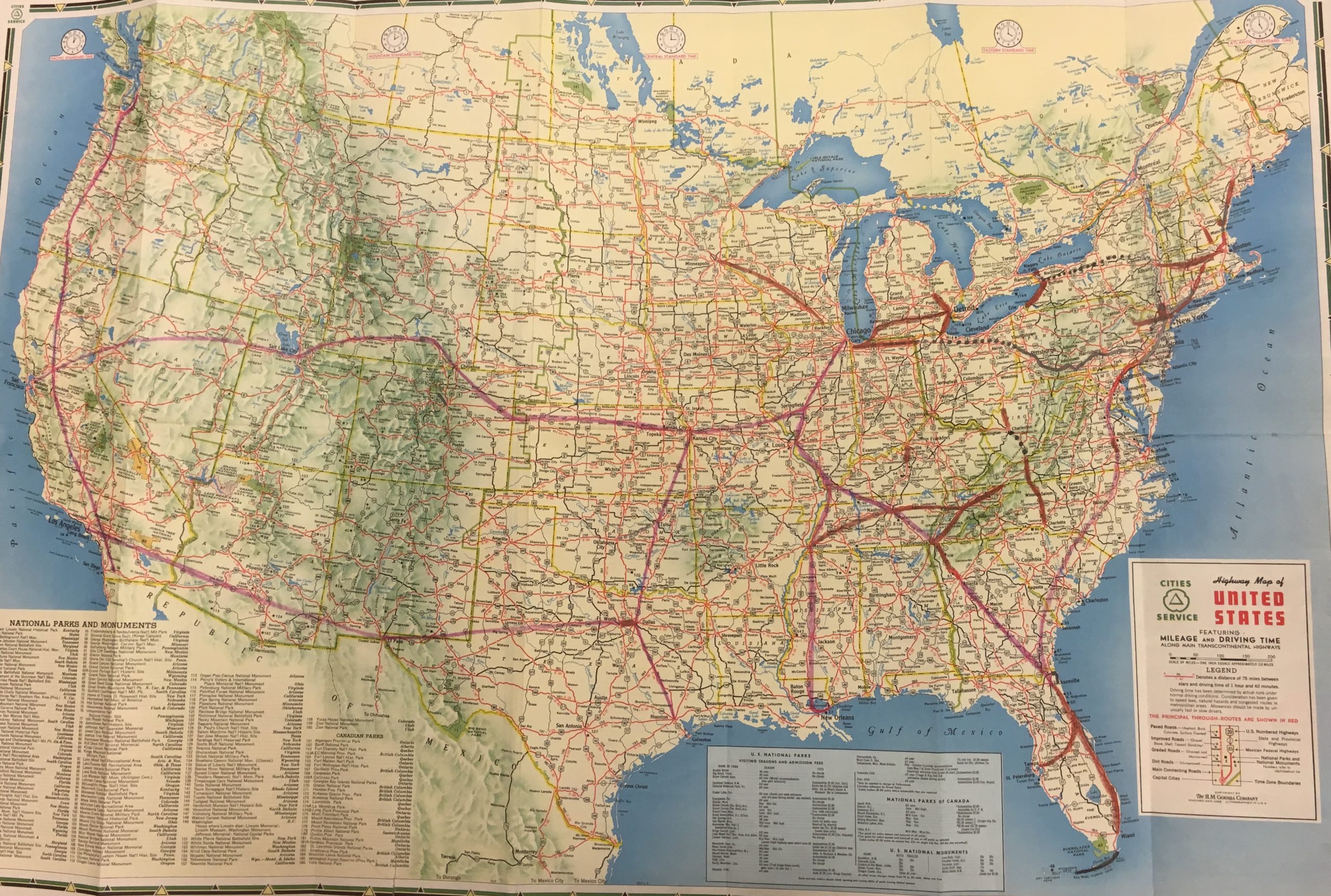
Proposed map of a 10,000-mile system of cross-country toll highways presented by President Eisenhower by Walter Bucker, February 1953.
Eisenhower gave it to his aide Gabriel Hauge, with instructions to initiate a government-wide study:
I am personally convinced that, in a number of fields, this Administration will have to come forward, at a reasonably early date, with a constructive program that will be designed to meet, in a well-rounded and imaginative way, the constantly increasing needs of a growing population. Our cities still conform too rigidly to the patterns, customs, and practices of fifty years ago. Each year we add hundreds of thousands of new automobiles to our vehicular population, but our road systems do not keep pace with the need.[3]
Eisenhower’s original focus was on “self-liquidating” projects that would eventually pay for themselves (principally toll roads, with possible federal bond guarantees). However, there was already an ongoing federal-aid highway program (started in 1916), largely run by states but with the federal government paying 50 percent of all costs. As one of the largest federal aid programs (funded at $550 million per year when Eisenhower took office), the highway program was a major component of the intertwined financial relationships between various levels of government.
In March 1953, Eisenhower asked Congress to create a blue-ribbon Commission to Study Federal, State, and Local Relations, and Congress responded with a law creating the panel (67 Stat. 145) on July 10 of that year.[4] From then on, the White House was reluctant to make major plans to change federal aid programs so as not to pre-judge the determinations of what came to be known as the “Kestnbaum Commission” after its second chairman.
The regular federal-aid highway program was on a two-year reauthorization cycle in even-numbered years, and while the Commerce Department (home of the Bureau of Public Roads) urged a fundamental restructuring of the program (including the “abandonment of present Federal aid policy”) in November 1953,[5] the President’s 1955 budget in January 1954 simply proposed extending the existing program for two more years at a budget freeze level, during which time the Administration would study the issue further.
The Administration was talked by the Republican-majority Congress into accepting a $300 million per year increase in the program (52 percent), in the final 1954 Highway Act (68 Stat. 70) enacted on May 6. In his statement upon signing the 1954 Act, Eisenhower noted that “Our highways badly need modernization and expansion,” and that even though the funding under the bill was an all-time high, “the needs are so great that continued efforts to modernize and improve our obsolescent highway system are mandatory.”[6] The 1954 law also commissioned several major studies that would inform future legislation.
In addition, the 1954 law helped solve some disputes that would arise later about which roads should be the top federal priority. The 1954 law put $175 million per year, for two years, towards the 40,000-mile National System of Interstate Highways that had been commissioned by Congress in 1944. The map for almost 38,000 miles of that system had been painstakingly negotiated between the 48 state highway bureaus and the federal government and agreed to by August 1947, so it would prove to be an easy default for the core federal interest instead of having the Eisenhower Administration draw up its own map of priority routes.
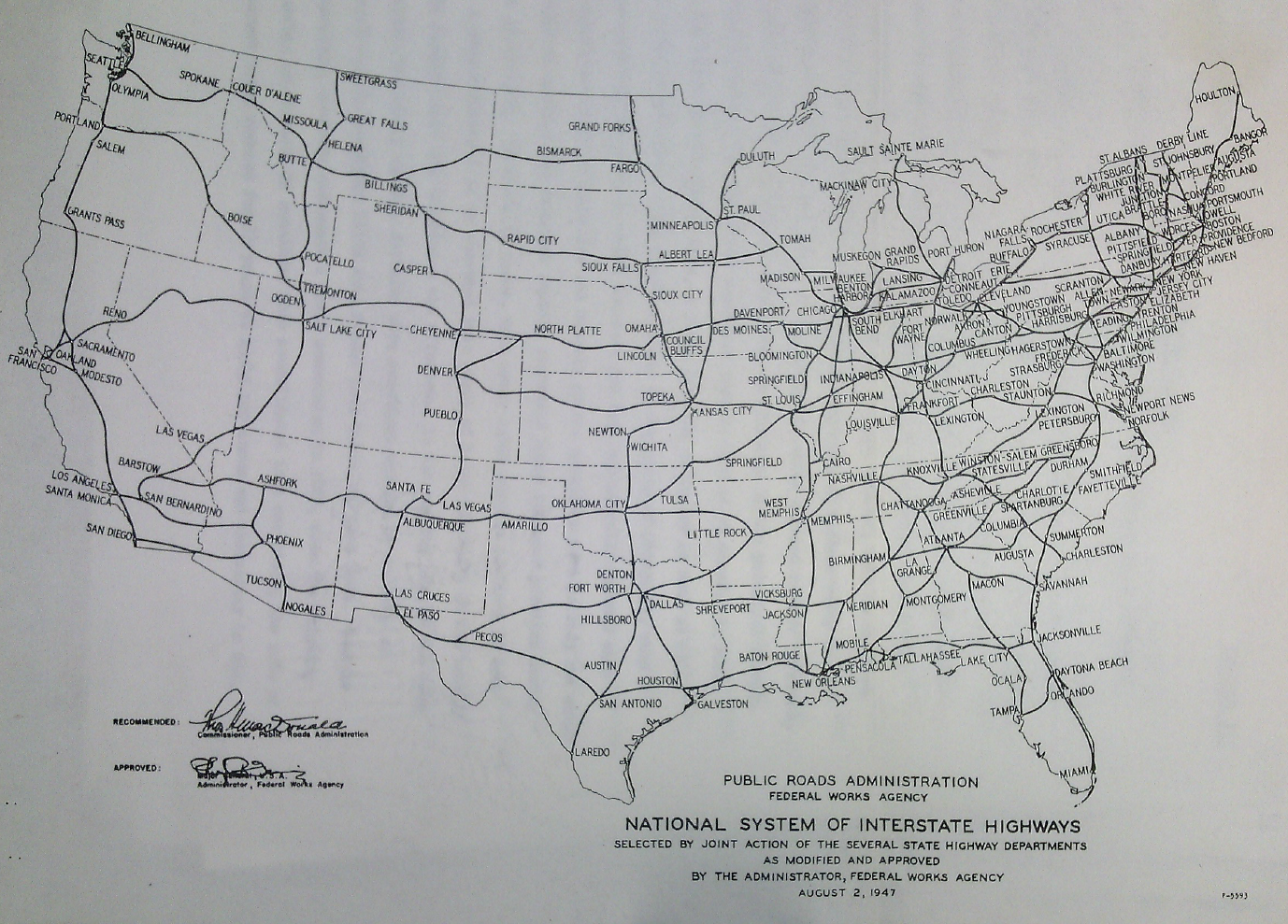
37,600-mile Interstate Highway System map approved by the Bureau of Public Roads, August 2, 1947.
Eisenhower’s chief of staff, Sherman Adams, was already having discussions about highway program expansion with legendary New York public works czar Robert Moses, who, along with New York highway commissioner Bertram Tallamy, drafted a proposed bill for Adams in May 1954 creating a “Continental Highway Finance Corporation” to subsidize the creation of a $15 billion transcontinental network of toll roads through guarantees of municipal bonds, direct federal loans, and some subsidies. The preamble of the bill said that the $15 billion for transcontinental toll roads was part of “an estimated grand total of fifty billion dollars to establish a safe, modern and adequate state and local highway system.”[7]
At the same time, Eisenhower’s Council of Economic Advisers was working on its own draft bill (in cooperation with Walter Buckner, with whom Eisenhower had consulted during the transition). By June 1954, that plan would have created a National Defense Highway Corporation to issue up to $45 billion in bonds to pay for a yet-to-be-designated system of national defense toll roads, which would become free roads after the construction loans were paid off.[8] And the Bureau of Public Roads was circulating a plan it had put together in summer 1953 calling for the federal government to build the Interstate Highway System designated in 1947 at a 100 percent federal share, paid for with the sale of new federal annuities based on the British “Consol.”[9]
There were clearly “too many cooks” in the kitchen, as Eisenhower’s aide for public works planning, Stewart Bragdon, noted.[10] President Eisenhower then did something that, for him, was rare – he decided to stir things up, in an extremely public way, without having a fully developed plan for the follow-through.
“$50 billion highway plan”
42 of the 48 state governors gathered for their annual conference in mid-July 1954 at a resort in upstate New York. At the first morning meeting, Meyer Kestnbaum, chairman of the Commission on Intergovernmental Relations, led a discussion of federal grants-in-aid programs that revealed significant disillusionment with the current federal-aid highway program, which was not returning the full amount of federal excise taxes on gasoline and automobiles to the states.[11] (Just two years prior, the Governors’ Conference had adopted a resolution urging the federal government “to withdraw from the field of gasoline taxes as soon as may be consistent with the needs of national defense.”[12])
President Eisenhower had planned to travel to New York and give the keynote speech to the governors that evening, but he had to beg off to attend his sister-in-law’s funeral. Instead, Vice President Nixon took his place, speaking from notes prepared by Eisenhower himself. Nixon said:
…at this session of the Congress, we have increased by approximately $500 million the federal monies available to the states for road development. This seems like a very substantial sum. But the experts say that $5 billion per year for ten years, in addition to all current, normal expenditures, will pay off in economic growth; and when we have spent $50 billion in the next ten years, we shall only have made a good start on the highways the country will need for a population of 200 million people.
A $50 billion highway program in ten years is a goal toward which we can – and should – work.[13]
In 1954, $50 billion was a huge number – the entire federal budget for fiscal 1955 proposed by Eisenhower only totaled $56.3 billion in new spending authority. Put another way, $5 billion per year in spending above current levels would have been an extra 1.3 percent of gross domestic product (the just-ended FY 1954 GDP was $387.2 billion). An extra 1.3 percent of GDP today would be $274 billion per year (FY 2019 GDP was $21.216 trillion). It was little wonder that the national media coverage of the speech led with the $50 billion number, and even the White House official files on the subject are labeled with “$50 billion highway plan” in quotation marks.
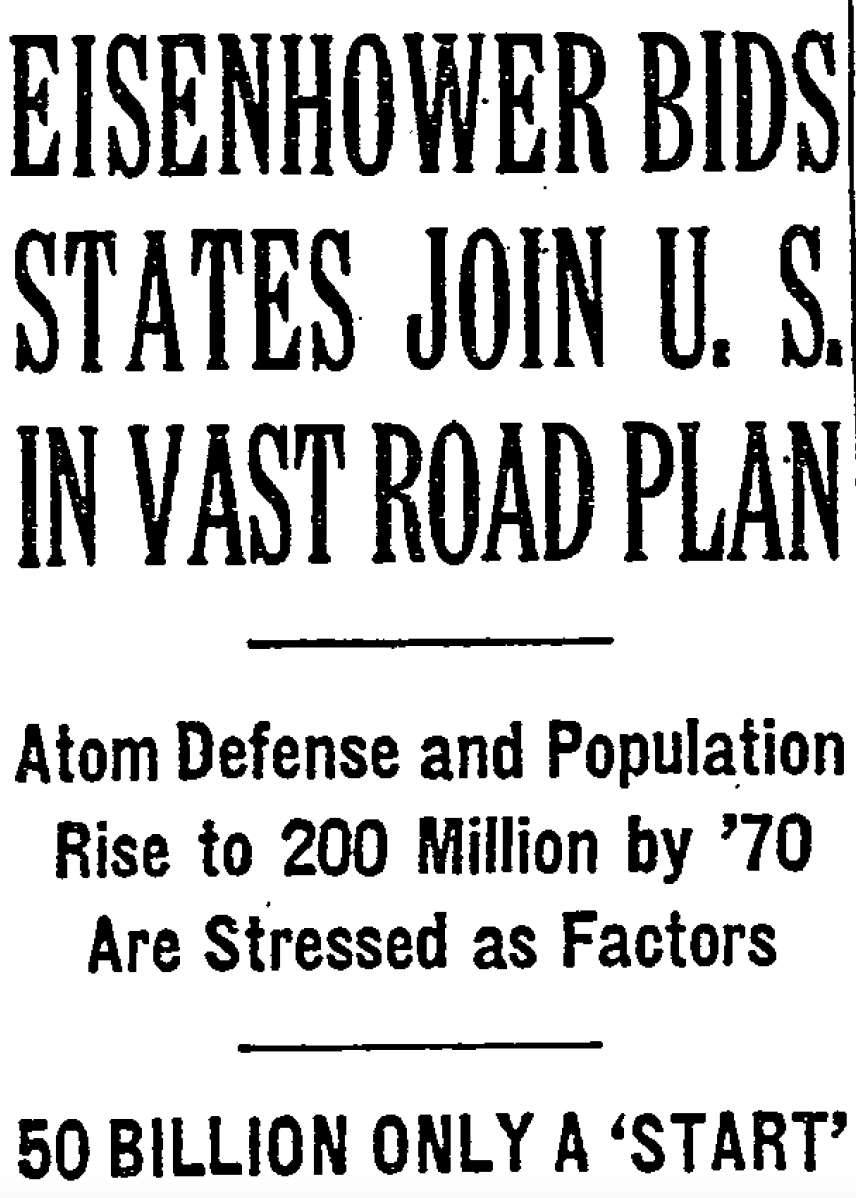
New York Times front-page headline the day after Nixon’s speech.
Nixon did mention Eisenhower’s belief that the financing should be “based on self-liquidation of each project, whenever that is possible, through tolls or the assured increase in gas tax revenue, and on federal help where the national interest demands it.”[14] He also stressed cooperative federalism and letting states manage their own areas.
And Nixon made a direct quote from Eisenhower’s notes to put some of the onus back on the states: “I hope that you will study the matter, and recommend to me the cooperative action you think the federal government and the forty-eight states should take to meet these requirements, so that I can submit positive proposals to the next session of the Congress.”[15]
Two days later, at his regular news conference, Eisenhower was asked about the $50 billion proposal, and admitted “I have no definite plan, although we have been studying it for a year with people from the outside because, of all people, we must have the Governors and legislatures with us. Until they come to me and show me their proposition and something that we can get together on, it is really idle to say how any single project will be financed…but, by and large, it should be local and, I would say, exploit the self-liquidating idea as much as possible.”[16]
More highway study committees
Federal aid programs like highways were already the subject of the Kestnbaum Commission’s studies, and Eisenhower had just asked the governors to form their own study committee. He then followed this up by ordering two more highway study committees: one inside the federal government (the “Inter-Agency Committee on the President’s Highway Program”) to be chaired by the Bureau of Public Roads and to work in private, as well as an outside panel of experts to work in public. The outside panel would be in charge of working through the recommendations of the governors, the inter-agency panel, and suggestions from the state highway bureaus.
To chair the outside commission, Eisenhower first approached Roger Kyes, who until recently had served as Under Secretary of Defense but had since returned to his job at General Motors, where he was in charge of convincing cities to tear up their streetcar systems to replace them with buses. Kyes declined the job, telling Eisenhower in a telegram that “what might be considered selfish interest of corporation in such a program could prove detrimental to my effectiveness.”[17]
So Eisenhower then turned to his wartime subordinate and close confidant, General Lucius Clay. Clay came to Washington on August 30 to have breakfast with the President, Sherman Adams and the head of the Governors’ Conference highway study committee to come up with a plan of action. It was decided that the members of the “Clay Committee” would not be stakeholders – no state or local officials, no road contractors. The committee members would be men of accomplishment in other fields, and the stakeholders would be able to express their views “by direct and constant liaison.”[18]
(The parallel Inter-Agency Committee, headed by the Commerce Secretary, wound up not having much to do while the Clay Commission worked, as the minutes of its meetings attest. Mark H. Rose and Raymond A. Mohl, in their book Interstate: Highway Politics and Policy since 1939, describe a process whereby Clay ignored many of the recommendations of the Interagency Committee and formed his own plan: “Few in the government besides Clay himself, Eisenhower, and Adams approved each feature of Clay’s plan…but in meetings with Interagency Committee members, Clay remainder adamant; modifications were bad politics…As far as Clay was concerned, sufficient incentives were built into his program to guarantee support. Unless members of the interagency group affirmed his financing proposals, he preferred that they not forward his plan at all.”[19])
The full membership of the Clay Committee was decided by August 30 and announced on September 7, and they held two days of public hearings the following month. The panel faced three related questions: which new roads to build, how to finance the program, and how it should relate to the regular federal-aid highway program.
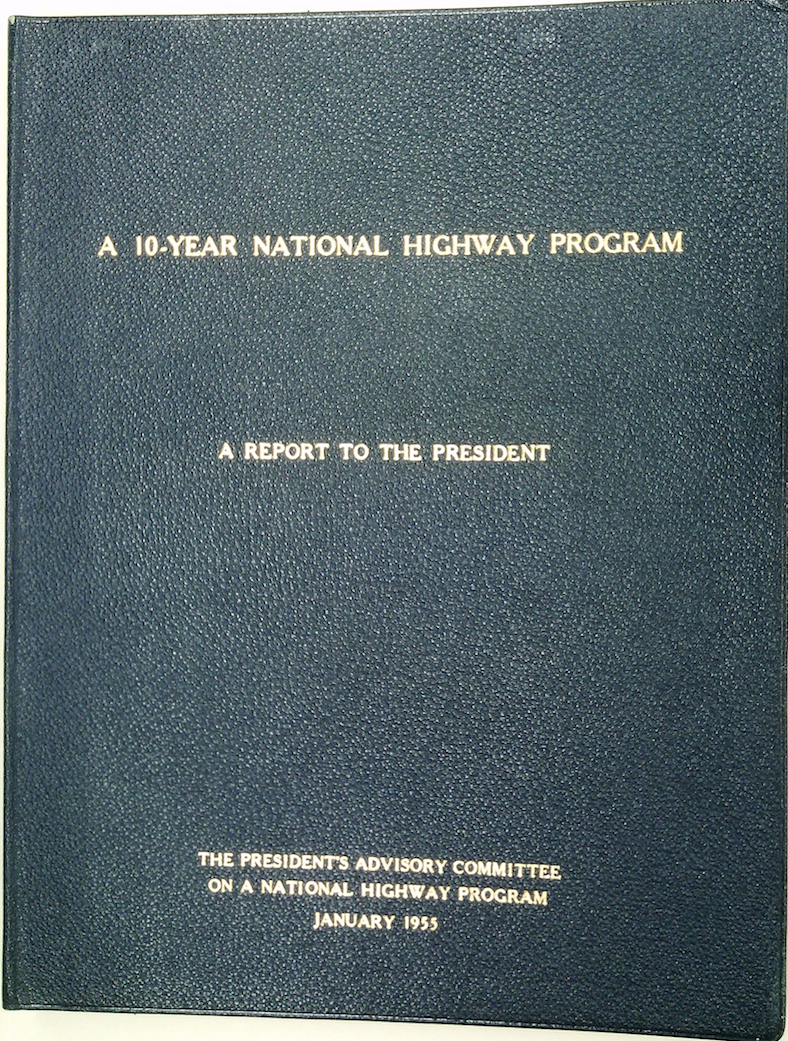
President Eisenhower’s personal copy of the Clay Committee report. Located in OF-141-B-1-B, Eisenhower Library.
In its report, Clay Committee made several pivotal decisions. They used the Commerce Department’s March 1955 highway cost estimate as a foundation – $101 billion in nationwide construction needs over ten years, with $68 billion of that on the various federal-aid systems. They decided that, instead of picking and choosing routes of national interest, they would just stick with the Interstate system as selected by the states and BPR in 1947, and use the latest $23 billion estimate of total funding needed to build and improve that system through 1965 (plus a $4 billion placeholder for the missing urban routes not yet selected). The Committee rejected a system of nationwide toll roads as unworkable. They also recommended keeping the existing federal-aid highway program going (which contradicted Commerce’s 1953 plans to eliminate funding for that system) – the Clay plan would have maintained the existing federal-aid and forest highway programs at a flat-lined total of $622.5 million in contract authority per year.
But instead of raising taxes to build the Interstate, the Clay plan called for the establishment of a Federal Highway Corporation to oversee construction of the Interstate system. The Corporation would issue an estimated $20.2 billion in bonds over ten years to supplement the estimated $4.8 billion in appropriations for a total ten-year (1956-1965) federal commitment of $25 billion towards Interstate. The bonds would be secured by “a contract between the Corporation and the Treasury Department under the terms of which, it should be provided that the Corporation will receive certain specified amounts annually as authorized by Congress, always sufficient to meet its obligations.”[20]
The Clay plan also called for the relative federal-versus-state cost burden for highways to be reworked. The traditional federal-aid program was a 50-50 federal-state split of costs, and the 1954 highway law, which provided the first funding for Interstate construction ($350 million), increased the federal share to 60 percent of the cost of Interstate projects. But the Clay Committee called for increasing the federal share of Interstate construction to an estimated 92.6 percent ($25 billion out of an estimated $27 billion), while dropping the federal share of the federal-aid primary program (now including urban routes) to 13.1 percent and the federal share of the federal-aid secondary program to 14.0 percent. Overall, the federal share of anticipated projects on all federal-aid systems (including Interstate) would average 43.2 percent.
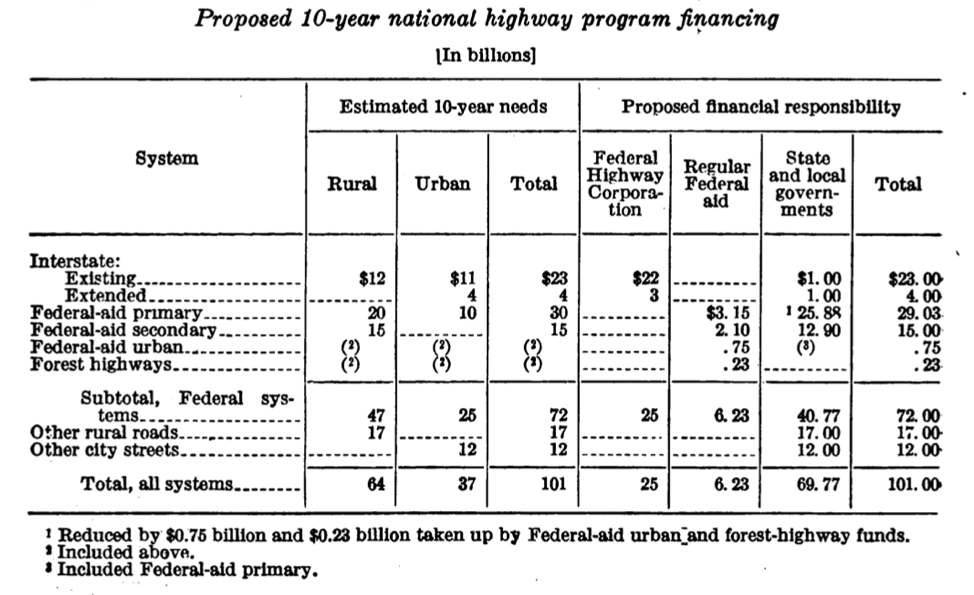
The funding summary table from the Clay Committee’s report.
The Budget Bureau and Treasury Department were finally given copies of the final Clay Committee report on December 30, 1954, Clay briefed key legislators at a dinner on January 7 at the Statler Hotel, and Clay formally presented President Eisenhower with printed copies of the report on January 11, 1955. (Clay’s secretary mis-typed the date on the cover letter as being in 1954 instead of 1955.)
Continued in Federal Highway Policy Under President Eisenhower, 1953-1954
[1] See https://www.eisenhowerlibrary.gov/research/online-documents/1919-transcontinental-motor-convoy
[2] Located in DDE’s Papers as President, Ann Whitman File, Name Series, Box 3, “BUCKNER, Walker Gentry” folder; Eisenhower Library.
[3] Memorandum from President Eisenhower to Gabriel Hauge, February 4, 1953. Reprinted in The Papers of Dwight David Eisenhower, volume 14, document 20 beginning on p. 23.
[4] Dwight D. Eisenhower, Special Message to the Congress Recommending the Establishment of a Commission To Study Federal, State, and Local Relations, March 30, 1953. Public Papers of the Presidents of the United States: Dwight D. Eisenhower, 1953. Document 39 on p. 139.
[5] Office of the Under Secretary of Commerce for Transportation, “Federal Highway Policy,” November 19, 1953. Located in DDE’s Records as President, Official File, Box 610, OF-141-B (2), Eisenhower Library.
[6] Dwight D. Eisenhower, Statement by the President Upon Signing the Federal-Aid Highway Act of 1954, May 6, 1954. Public Papers of the Presidents of the United States: Dwight D. Eisenhower, 1954. Document 102 on p. 459.
[7] Robert Moses and Bertram Tallamy letter to Sherman Adams with enclosures, May 4, 1954. Located in John Stewart Bragdon Records, 1949-61; Box 58; folder entitled “Moses-Tallamy Plan;” Eisenhower Library.
[8] Draft bill dated June 1, 1954 and correspondence with Walter Buckner located in John Stewart Bragdon Records, 1949-61; Box 59; folder entitled “National Defense Highway System;” Eisenhower Library.
[9] U.S. Bureau of Public Roads, “A Plan for National Highways for Peace or Defense.” Undated, but an April 23, 1954 cover letter from Public Roads Commissioner F.V. du Pont to General John S. Bragdon states that the plan was “developed last summer.” Located in John Stewart Bragdon Records, 1949-61; Box 37; folder entitled “Highways – 1954 (April through August);” Eisenhower Library.
[10] Memorandum from J.S. Bragdon to Arthur F. Burns with subject line “National Highway System,” June 21, 1954. Located in John Stewart Bragdon Records, 1949-61; Box 59; folder entitled “National Defense Highway System;” Eisenhower Library.
[11] The Governors’ Conference. Proceedings of the Governors’ Conference 1954, Forth-Sixth Annual Meeting at Bolton Landing, Lake George, New York, July 11-14, 1954, pp. 13-48. Published by the Governors’ Conference, Chicago, Illinois.
[12] The Governors’ Conference. Proceedings of the Governors’ Conference 1952, Forth-Fourth Annual Meeting at Houston, Texas, June 29 – July 2, 1952, p. 195. Published by the Governors’ Conference, Chicago, Illinois.
[13] Richard M. Nixon, Proceedings of the Governors’ Conference 1954, p. 90.
[14] Ibid p. 91.
[15] Ibid p. 92.
[16] Dwight D. Eisenhower, The President’s New Conference of July 14, 1954 Public Papers of the Presidents of the United States: Dwight D. Eisenhower, 1954. Document 165 on p. 629 (quote is on p. 636).
[17] Telegram from Roger Kyes to Dwight D. Eisenhower, July 24, 1954. Located in DDE’s Records as President, Official File, Box 613, OF-141-B-1-B (1), Eisenhower Library.
[18] Memorandum from Lucius Clay to President Eisenhower, August 30, 1954, Located in DDE’s Records as President, Official File, Box 613, OF-141-B-1-B (1), Eisenhower Library.
[19] Mark H. Rose and Raymond A. Mohl, Interstate: Highway Politics and Policy since 1939 (Third Edition). Knoxville: University of Tennessee Press, 2012, pp. 76-77.
[20] President’s Advisory Committee on a National Highway Program. A 10-Year National Highway Program: A Report to the President. January 1955. Printed as part of House Document No. 93, 84th Congress, 1st Session (National Highway Program), p. 21.








